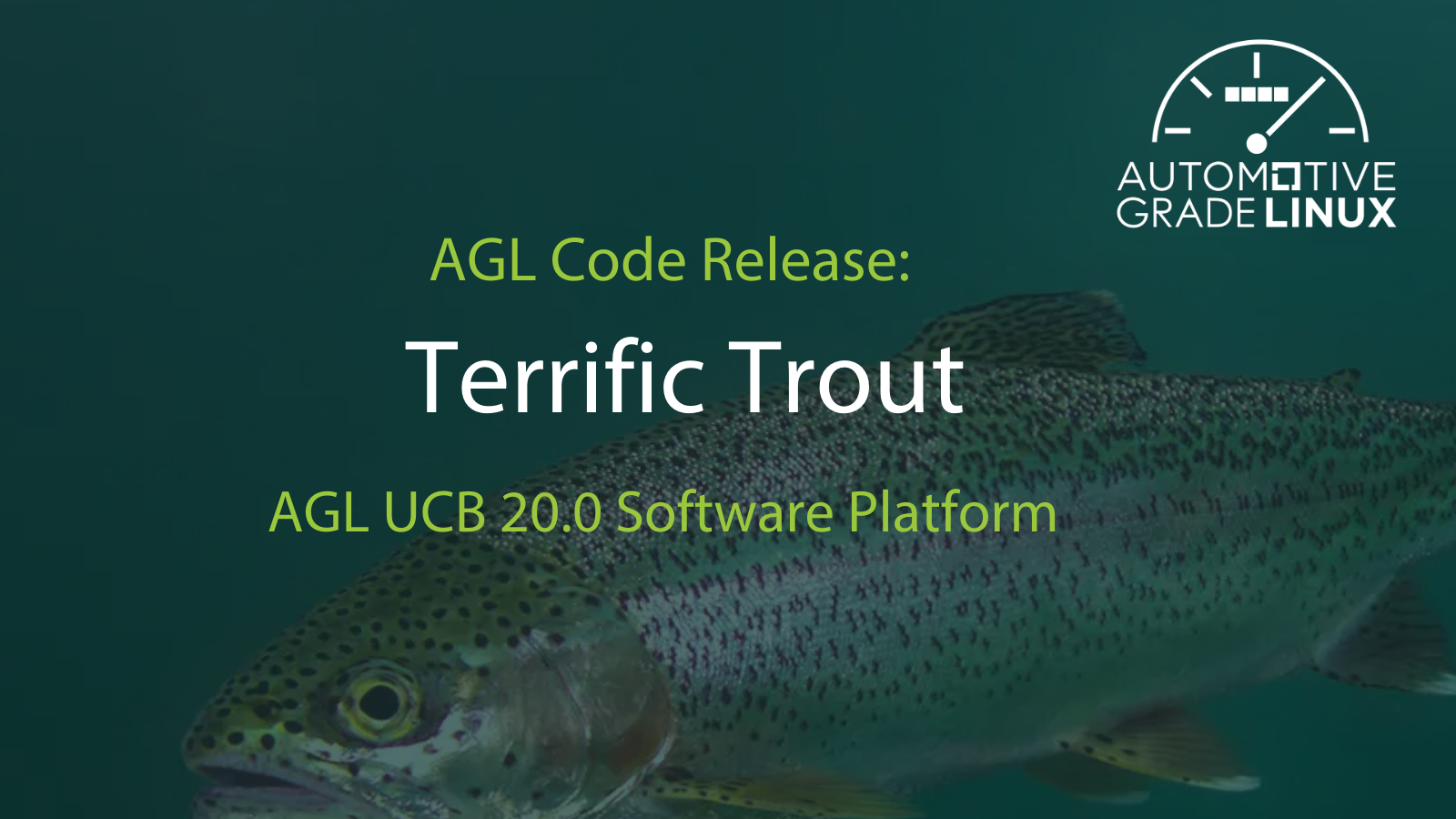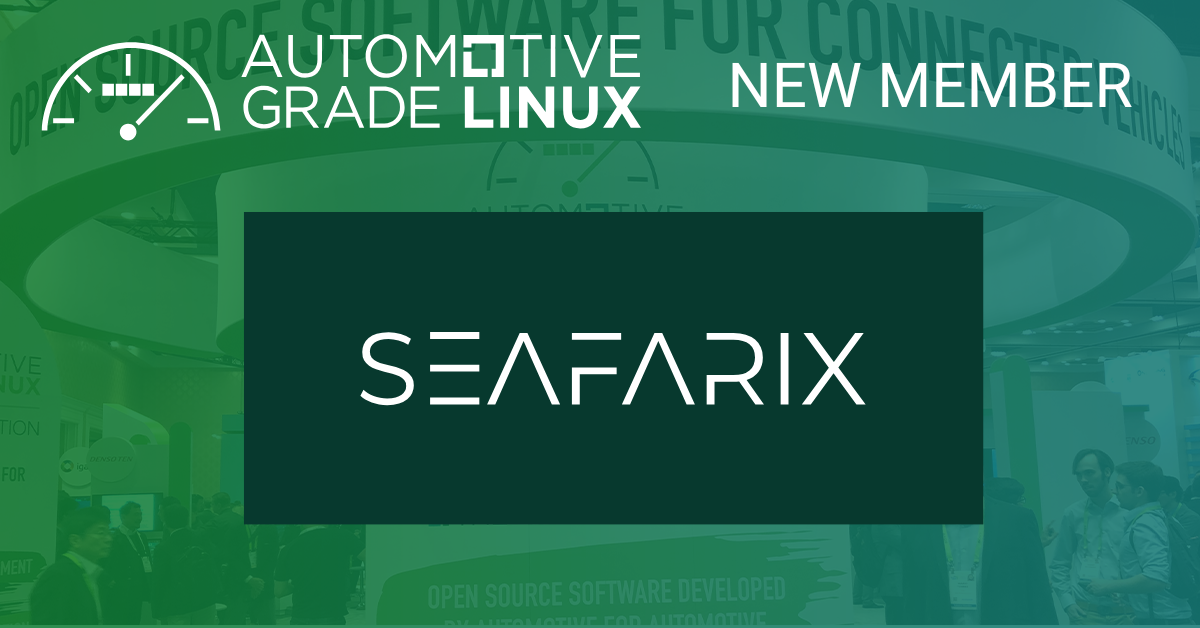AGL previews speech recognition APIs and upcoming platform release; DENSO, ForgeRock, LG, Panasonic, Renesas and others demonstrate connected car services, audio innovations, instrument cluster, and security solutions running on AGL technology
SAN FRANCISCO, December 7, 2018 – Automotive Grade Linux (AGL), an open source project at the Linux Foundation developing a shared software platform for in-vehicle technology, will preview new speech recognition APIs with Amazon Alexa at CES 2019, along with infotainment and instrument cluster demonstrations using the award-winning AGL Unified Code Base (UCB).
The AGL booth in the Westgate Hotel Pavilion, booth 1614, will also feature a 2019 Toyota RAV4 with an AGL-based infotainment system and automotive technology demonstrations from AGL members AISIN AW, Audiokinetic, Cognomotiv, DENSO, DENSO TEN, EPAM Systems, Fiberdyne Systems, ForgeRock, Igalia, LG Silicon Valley Lab, Microchip, NTT DATA MSE, Panasonic, Renesas, SafeRide Technologies, Tuxera and VNC Automotive. The booth will be open to the public during CES show hours from January 8-11, 2019.
“Our goal is to speech-enable every application in the vehicle and make it easy for developers to do so. We are very excited to preview our speech recognition APIs through our AGL demo featuring Amazon Alexa at CES,” said Dan Cauchy, Executive Director of Automotive Grade Linux at the Linux Foundation. “Commercial implementations of AGL-based products continue to be introduced to the market, and we are excited to have 20 AGL demos including a 2019 Toyota RAV4 with Entune 3.0 in our booth to demonstrate how companies are using the AGL platform as the starting point to create their own innovative products and services.”
The AGL UCB platform was recently recognized as a CES 2019 Innovation Awards Honoree. Developed through a joint effort by dozens of member companies, the UCB is an open source software platform for infotainment, telematics and instrument cluster applications. Sharing a single software platform across the industry reduces fragmentation and accelerates time-to-market by encouraging the growth of a global ecosystem of developers that can build a product once and have it work for multiple automakers. The new speech recognition APIs support multiple voice agents and will be available with the release of the AGL UCB 7.0 in January 2019.
Many AGL members have already started integrating the UCB into their production plans. Mercedes-Benz Vans is using AGL as a foundation for a new onboard operating system for its commercial vehicles. Toyota’s AGL-based infotainment system is now in Toyota and Lexus vehicles globally and will be on display in the AGL booth in a 2019 Toyota RAV4.
Automotive Grade Linux Demos at CES 2019
The AGL booth will feature several core UCB demos developed collaboratively by the AGL community, as well as 20 product and proof of concept (PoC) demos by AGL members.
Core AGL UCB Demos:
- Amazon Alexa: Access Alexa through speech recognition APIs integrated into AGL. Check the weather, place phone calls and play music and audiobooks.
- Instrument Cluster: Speedometer and tachometer along with a center display that shows information from the infotainment system such as map data and media player information.
- Infotainment: Reference applications including media player, tuner, navigation, web browser, Bluetooth, WiFi, HVAC control, audio mixer and vehicle controls
Demos by AGL members:
- Aisin AW, Robust and Safe System with AGL: The architecture of a system that integrates AGL-based IVI systems and safety functions such as instrument clusters.
- Audiokinetic, Wwise Automotive: Auditory displays for HMI and safety applications using Wwise Automotive authoring, profiling, and real-time editing tools fully integrated within the AGL platform.
- Cognomotiv, Vehicle Systems Health Score: The Cognomotiv AI-modeling solution running on AGL to dynamically assess the health of the entire automotive system during operation/runtime including detecting and predicting faults, failures, malfunctions and misbehaviors using real time data from multiple automotive systems (CAN, OBDII, Drive Compute).
- DENSO, AGL Cockpit System: Voice control and Auto Pilot with Connected car service; Yelp, Spotify, Parking Assistant manager, and Anomaly detection.
- DENSO TEN, AGL Vehicle Data Demonstration: AGL Vehicle Data demonstration using real vehicle data from the CAN bus and LIN bus with support for Renesas R-CAR and Intel SoC.
- EPAM Systems, Aos: Aos, a Connected Services Management and Orchestration System, enables OEMs and Tier 1 OEMs to manage connected services deployment to the cloud and onboard computer.
- Fiberdyne Systems, Advanced Audio Processing: AGL platform running Fiberdyne’s AVIRT virtual sound card implementation on the Renesas R-Car M3 platform with an advanced DSP audio library and Graphical Mixer interface connected via MOST150 INICnet to the Fiberdyne CES 2019 award winning 9 channel amplifier.
- ForgeRock, Vehicle-to-Cloud Security & Privacy: AGL identity and privacy layer establishing a cryptographically trusted digital identity of the vehicle to authenticate and authorize vehicle-to-cloud communications including streaming both anonymous and user-consented telematics data, and dynamically managing fine-grain access control to real-time data flowing from the vehicle to the cloud.
- Igalia, Chromium-based Runtime: AGL HMI running both native and web-based IVI applications seamlessly on different hardware architectures; updated version of Chromium running on the AGL platform and its integration with the Web Runtime and the new Web Application Manager (WAM), which allows IVI applications to run on HTML5 with the same degree of integration and security as native apps.
- LG Silicon Valley Lab, Autonomous Vehicle Simulator: Autonomous vehicle cockpit showcasing LG’s open source Unity-based 3D driving simulator with Baidu’s Apollo, all controlled from a web-based dashboard (with integrated rear seat entertainment) powered by the Enact framework running in LG’s Web App Manager (WAM), bringing easy, flexible web app development and great user experience to AGL from LG’s highly-acclaimed webOS.
- Microchip, Networked Microphone Arrays Over Low Latency INICnet™ Technology with AGL: Showcases how distributed microphones/microphone arrays can be powered, networked and controlled over a single Unshielded Twisted Pair (UTP) copper wire from a centralized root node running on the AGL system. It also shows how easy it is for voice assistants and audio processing software (e.g. speech recognition) to interface to an AGL system through a standardized API fully abstracted from hardware.
- NTT DATA MSE, Application Examples of SmartDeviceLink (SDL) Implemented on AGL: Running SDL-enabled applications which support preventing driver distraction through leveraging vehicle data on AGL and managing permissions of SDL-enabled applications in cooperation with SDL Policy Server. SmartDeviceLink is a technology which connects smart devices to In-Vehicle Infotainment systems.
- Panasonic, Next-Generation AGL Reference System: A proposal of the reference hardware platform for AGL development which can be installed in vehicle, and the experience of an AGL cockpit system in VR using HMD (Head Mounted Display) and the reference platform.
- Renesas, R-Car: Connected Car Platform Solution for AGL: R-Car gen3 based application server concept with universal connectivity, cloud assisted application runs on Chromium and AWS cloud connector (greengrass core) runs on AGL.
- SafeRide Technologies, vSentry™: Multi-layer cybersecurity software solution for connected and autonomous vehicles that combines deterministic and zero false-positive protection for software network and connectivity – including IDPS, Firewall and Access Control – with a Machine Learning and Deep Learning profiling and anomaly detection technology for future-proof security.
- Toyota, Entune 3.0: 2019 RAV4 with next-generation infotainment system based on AGL.
- Tuxera, Ubiquitous QuickBoot: Two infotainment systems running AGL, one of which is powered with Ubiquitous QuickBoot by Tuxera, which brings full access to the car’s IVI system within a few seconds. There is a relay button connected to the IVIs which can, shortly, disconnect the power of both systems simultaneously. Once pressed, the button initiates a “cold boot” scenario for the systems – showcasing the boot time improvement in a real-time scenario.
- VNC Automotive, Connectivity Solution: Connected car solution enabling connectivity between smart devices, the car and the cloud. First showing of full remote control of both iOS and Android devices, plus all popular connectivity standards including Android Auto, CarPlay, MirrorLink, SmartDeviceLink, and Baidu CarLife.
About Automotive Grade Linux (AGL)
Automotive Grade Linux is a collaborative open source project that is bringing together automakers, suppliers and technology companies to accelerate the development and adoption of a fully open software stack for the connected car. With Linux at its core, AGL is developing an open platform from the ground up that can serve as the de facto industry standard to enable rapid development of new features and technologies. Although initially focused on In-Vehicle-Infotainment (IVI), AGL is the only organization planning to address all software in the vehicle, including instrument cluster, heads up display, telematics, advanced driver assistance systems (ADAS) and autonomous driving. The AGL platform is available to all, and anyone can participate in its development. Learn more: https://www.automotivelinux.org/
Automotive Grade Linux is a Collaborative Project at The Linux Foundation. Linux Foundation Collaborative Projects are independently funded software projects that harness the power of collaborative development to fuel innovation across industries and ecosystems. www.linuxfoundation.org
###
The Linux Foundation has registered trademarks and uses trademarks. For a list of trademarks of The Linux Foundation, please see our trademark usage page: https://www.linuxfoundation.org/trademark-usage. Linux is a registered trademark of Linus Torvalds.
Media Inquiries
Emily Olin
eolin@linuxfoundation.org
pr@automotivelinux.org



